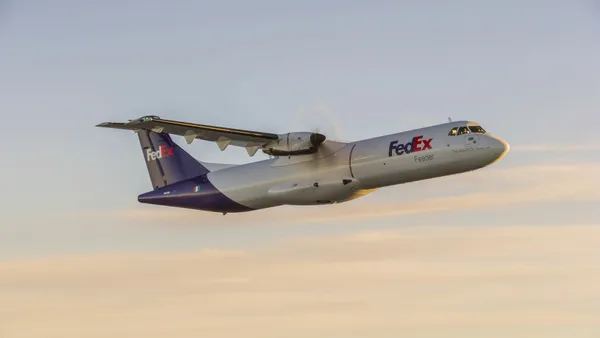Dive Brief:
- UPS will raise peak surcharges on shipments from mainland China and Hong Kong to the U.S. starting Oct. 25, after it lowered surcharges on Oct. 4. The new surcharges will last until further notice, according to an update from the carrier.
- Surcharges on shipments from Australia, Indonesia, Malaysia, New Zealand, Philippines, Singapore, Taiwan, and Vietnam are remaining steady since surcharges more than tripled on Aug. 30; UPS has not announced any planned decreases to these rates.
- UPS Worldwide Express Freight from Europe to the U.S. and North America will increase from 34 cents to 91 cents per pound starting Nov. 1. All other international shipment surcharges remain at levels set back in April, until further notice.
UPS peak surcharges per pound from mainland China and Hong Kong to U.S.
| Service | Oct. 4 to Oct. 24 | Oct. 25 until further notice |
|---|---|---|
| UPS Worldwide Express Plus | $0.79 | $1.02 |
| UPS Worldwide Express | $0.79 | $1.02 |
| UPS Worldwide Saver | $0.79 | $1.02 |
| UPS Worldwide Expedited | $0.75 | $0.98 |
| UPS Worldwide Express Freight | $1.59 | $1.81 |
| UPS Worldwide Express Freight Midday | $1.59 | $1.81 |
Source: UPS
Dive Insight:
A surge in demand for airfreight during the pandemic, coupled with peak season needs, has pushed UPS to once again raise fees on goods flowing from China and Hong Kong to the U.S. Increased surcharges for express freight from Europe to North America suggests that volume is on the rise, making capacity security an even greater priority for shippers.
The ever-changing shipping rates that have plagued shippers this year has made it increasingly hard to get a good handle on negotiating prices and goal setting for peak season and the future. And while airfreight rates are still below the apex in May, they have been steadily increasing since early July.
With holiday season upon us, shippers are yet again forced to shell out higher prices without many other options to get goods to market. Decreased capacity and higher rates have been a staple this year, causing fluctuating prices in air cargo especially, and in order to secure space, shippers have paid higher rates and additional surcharges.
UPS has tinkered with surcharge prices throughout the pandemic, increasing and decreasing prices as it adjusted to capacity and demand. This latest uptick is a reverberation of its approach to be more selective in the volume it ships from China to the U.S., focusing on quality and margin rather than volume. The move fits CEO Carol Tomé's strategy of UPS prioritizing the most valuable shipments as she laid out on an earnings call in July.














